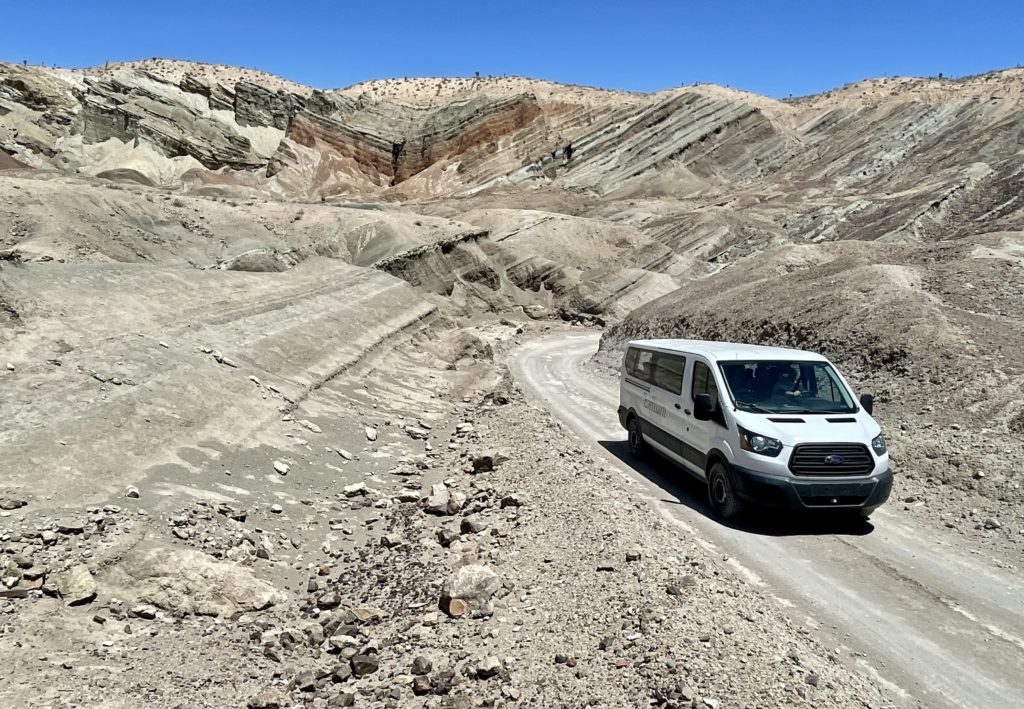Researchers from Earlham College pioneered new methods this summer to locate fossils found in 16-million-year-old bedrock in the Mojave Desert.
Using GPS and drone technologies, a student-faculty team scanned the desert surface from the air and created 3D digital models that helped identify new fossil locations. The team’s work is being used by paleontologists from the Western Science Center in Hemet, California, to continue their research on the ancient ecology of Southern California and expand their collections.
“Historically, paleontologists have returned to locations in the desert where fossils have already been found. The spiky vegetation and steep terrain make this a hard place to work and it’s very time consuming,” said Andy Moore, Earlham professor of earth and environmental science, who is leading the pilot program.
“We’ve discovered that you can use photogrammetry to digitally model and manipulate the landscape in 3D to identify continuations of fossil-bearing rock in areas that are difficult to see from the ground,” he said.
To test if their method would work, the team returned to a site they had mapped previously.
“We were thrilled to find prehistoric camel and three-toed horse bones in a new location identified using our preliminary digital model.” added Shannon Hayes, Earlham’s geology curator, and a co-leader on the trip.
Moore and Hayes brought students Meeghan Kersten and Karol Chong to the desert for three weeks to carry out the work. They operated drones and mapped with a GPS base station and rover, created digital landscape models from the data, and learned how the museum uses similar photogrammetry techniques to create 3D-printed models of fossils.

The trip was supported by Earlham’s summer research program, the CBB Student/Faculty Research Support Fund and the Ansel Gooding Research Fund.
“This trip allowed me to combine my passion for geology and photography,” said Kersten, an art and earth and environmental science double-major from Philadelphia, Pennsylvania.
“I had not used a drone before, and it was all very cool,” she said. “A lot of people use drones for fun, but learning how to use them and program for this kind of work was a great experience. I also got to build a portfolio of photography for the trip and identify a potential career path after Earlham.”

The liberal arts in practice
The connection between Earlham and the Western Science Center has been a relationship 40 years in the making. Moore was college roommates with Alton Dooley, executive director of the Western Science Center.
“I’m a geomorphologist and Alton is a vertebrate paleontologist,” Moore said. “Without our personal relationship, there’s no way the two of us would meet like this in the field. There’s a professional divide.
“That’s one of the big reasons you come to a small liberal arts college and not a big state school,” he said. “You get to have a much closer relationship with faculty and it is expected that you develop close relationships with the kids you go to class with,” he said. “There’s value in doing this. We know our students very well, and we were able to tailor this experience specifically to their interests.”
The relationship between Earlham and the museum has been mutually beneficial. When the Western Science Center was established in 2006, its original purpose was to house a collection of mastodon fossils. The modern museum has grown into a sprawling research campus with growing exhibits and a K-12 magnet school.
“Organizations such as the Western Science Center thrive on the diverse, multi-disciplinary approach to problem solving that is at the core of a liberal arts education.” Dooley said. “When Andy and I decided to undertake this collaborative project, we knew there would be unforeseen benefits both for the museum and for Earlham’s students, but we didn’t expect to find a new productive fossil locality in a matter of days.
“Besides the new fossil discoveries, our staff was exposed to the utility of drones in museum work for the first time, and are already looking at ways to incorporate that more fully into our operations, while Earlham’s students and staff were able to learn entirely new applications for the tools they were already using in their mapping activities.”
Van 12’s last cross-country research expedition
This research collaboration between Earlham and the Western Science Center is just getting started. A follow-up excursion is planned for next year in the Rainbow Basin Natural Area, a fossil-rich geological attraction in Barstow, California, that is known for its colorful rock layers.
The goal of the trip will be similar, but getting there will look a little different. “Van 12,” the trusty Ford Transit that has been used since 2017 for long-distance research excursions and field trips is being officially retired from Earlham’s fleet this year.
“We put on 78,000 miles on Van 12 just during the COVID pandemic,” Moore said. “The Earlham experience extends far beyond the classroom. Whether traveling on a class field trip or for research, we want students to get out and apply what they’ve learned,” Moore said.

In addition to the Mojave Desert, Van 12 has transported students to Florida’s Ten Thousand Islands, the Nova Scotia coast, Utah’s Uinta Mountains—even atop a hydroelectric dam in Missouri.
To give the beloved Van 12 a proper send off, Kersten created a tribute video and published it on YouTube.
“Van 12 has been such an important of the Earlham experience,” Kersten said. “It has taken people from one end of the continent to the other.
“Working with Andy and Shannon and leaving California with all of these awesome connections has been great. They are both so fun and I love both of them.”
Media contact
Brian Zimmerman
Director of media relations
Email: [email protected]
Phone: 765.983.1256